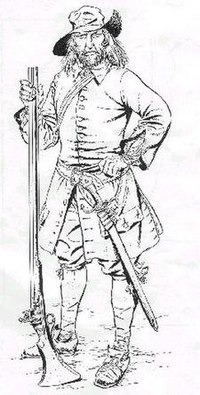George Woodbridge (illustrator)
George Woodbridge | |
|---|---|
 | |
| Born | October 3, 1930 Flushing, Queens, New York City |
| Died | January 20, 2004 (aged 73–74) New York City |
| Education | School of Visual Arts, New York City |
| Known for | Illustration |

George Woodbridge (October 3, 1930 – January 20, 2004) was an American illustrator known for his exhaustive research and historical accuracy, and for his 44-year run as a contributor to
Born in Flushing, Queens, Woodbridge studied illustration at Manhattan's School of Visual Arts.[3] In later years, he lived on Staten Island, where he created his detailed drawings of military uniforms, insignia and equipment.
Military history
He illustrated many military history books, including the Time/Life Civil War history, George Neumann's Collector's Illustrated Encyclopedia of the American Revolution and Frederick P. Todd's three-volume American Military Equipage, 1851–1872: A Description by Word and Picture of What the American Soldier, Sailor and Marine of These Years Wore and Carried. He was named a fellow of the Company of Military Historians in 1961.[4]
Woodbridge was an early advocate for and participant in the hobby of historical reenacting, particularly that of the American Revolution which was always a special interest of his. During the American Revolution Bicentennial of 1975 - 1981, he served as commander of the association of reenactors known as the Brigade of the American Revolution which participated in many events during the period.
Mad
In March 1957, Woodbridge began as a freelancer to Mad when Al Feldstein was the editor. Feldstein observed, "George's strong points were many. He was especially adept at delineating amusing street scenes with crowds and signs and outlandish going-ons, as well as depicting humorous interpretations of just plain people in comedic human situations. The articles he was assigned to illustrate were chosen with those superb talents in mind." Woodbridge remained with Mad for five decades. Later Mad editor John Ficarra noted, "He had a tremendous eye for detail that showed up in his drawings. We especially played to his history knowledge. When we gave him a piece on World War I, he would draw the exact gun and belt buckle they were using then."
Woodbridge illustrated several Mad books, such as Dick DeBartolo's A Mad Guide to Leisure Time and Mad's Cradle to Grave Primer (Warner Books, 1973), written by Larry Siegel and edited by Nick Meglin. When Bhob Stewart edited the Mad Style Guide in 1994, he gave Woodbridge the assignment of drawing the Mad Zeppelin from three different angles as a detailed guide for any company that might one day market a miniature model of the airship.
Woodbridge was color blind, yet he worked in color, as noted by cartoonist Sergio Aragonés, "He was such a good friend. He knew everything about history and he knew everything about artwork. When I was starting out and they gave me assignments that had to be in color, George was the one who helped me. Even though he was color blind, he did the most remarkable work in color. He was a wonderful man, and I will miss him very much."
Woodbridge told
Woodbridge admitted, however, that his least-favorite subject was sports. This was Jack Davis' specialty; but during the time Davis wasn't available, that work went to Woodbridge and he struggled. "That subject seemed to come so naturally to Jack," Woodbridge said. "But I really had to sweat those jobs." However, Woodbridge's most famous article for Mad was about sports, albeit a stupid, fictitious one. [See below.]
43-Man Squamish
For Mad No. 95 (June 1965), he drew the sports satire "
In the article, new terminology is introduced with no explanation; much of the humor derives from the reader's half-successful attempts at gleaning a meaning from context. Exactly what everyone on the team is supposed to do, exactly what penalties apply, and exactly when or why the "yellow caution flag" is to be flown remains far from clear, even after repeated readings.
Although writer Koch intended the game to be completely unplayable, some colleges even attempted to form teams and play the game. The letters column to MAD #97 included several "team photos" and accounts from new acolytes of the sport. A student from
Death
Woodbridge died of emphysema at age 73, on January 19, 2004, in a Staten Island hospital. He was survived by his second wife, Deborah, and by his first wife Ines and their sons, George, Curtis (also a professional illustrator), and Christopher Woodbridge.[3]
References
- ^ "The Art of George Woodbridge". Archived from the original on April 7, 2005. Retrieved December 16, 2013.
{{cite web}}: CS1 maint: bot: original URL status unknown (link), Historymakers.com - ^ Jones, William B. Classics Illustrated: A Cultural history. McFarland, 2006.
- ^ a b Nash, Eric. "George Woodbridge, 73, Artist For Mad Magazine Since 1950's", The New York Times, January 22, 2004. Accessed November 25, 2007.
- ^ List of Fellow of the Company of Military Historians http://military-historians.org/members/awards/fellows.htm
- ^ Living History Magazine, Spring, 1985
- ^ "Sweet Liberty – 86 – Michelle Pfeiffer".
- ^ Roberts, Sam (April 2, 2015). "Tom Koch, 89, Dies; Comedy Writer Invented a 43-Man Game". The New York Times.
